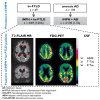Idiopathic normal pressure hydrocephalus and frontotemporal dementia: an unexpected association
- PMID: 36751501
- PMCID: PMC9897186
- DOI: 10.1093/braincomms/fcac319
Idiopathic normal pressure hydrocephalus and frontotemporal dementia: an unexpected association
Abstract
Idiopathic normal pressure hydrocephalus has a complex multifactorial pathogenesis and is associated with Alzheimer's disease in many patients. To date, it is not well known if a similar association exists with behavioural variant of frontotemporal lobar degeneration. In a first step, we compare the prevalence of idiopathic normal pressure hydrocephalus in two groups of patients, one with behavioural variant of frontotemporal lobar degeneration (n = 69) and the other with Alzheimer's disease (n = 178). In the second step, we describe more precisely the phenotype of patients with the association of idiopathic normal pressure hydrocephalus and behavioural variant of frontotemporal lobar degeneration. Firstly, we report that the prevalence of idiopathic normal pressure hydrocephalus was far higher in the group of patients with behavioural variant of frontotemporal lobar degeneration than in the group of patients with Alzheimer's disease (7.25% and 1.1%, respectively, P = 0.02). Secondly, we show that patients with the double diagnosis share common clinical and para-clinical features of both idiopathic normal pressure hydrocephalus and behavioural variant of frontotemporal lobar degeneration patients, including CSF shunting efficacy in real-life experience. Overall, our results suggest a link between these two conditions and should encourage neurologists to look for idiopathic normal pressure hydrocephalus in their behavioural variant of frontotemporal lobar degeneration patients in the event of gait disturbances; the benefit/risk balance could indeed be in favour of shunt surgery for selected patients with this newly described entity.
Keywords: Alzheimer’s disease; behavioural variant of frontotemporal lobar degeneration; idiopathic normal pressure hydrocephalus.
© The Author(s) 2022. Published by Oxford University Press on behalf of the Guarantors of Brain.
Figures





Similar articles
-
The graded multidimensional geometry of phenotypic variation and progression in neurodegenerative syndromes.Brain. 2025 Feb 3;148(2):448-466. doi: 10.1093/brain/awae233. Brain. 2025. PMID: 39018014 Free PMC article.
-
Diminished preparatory physiological responses in frontotemporal lobar degeneration syndromes.Brain Commun. 2022 Apr 4;4(2):fcac075. doi: 10.1093/braincomms/fcac075. eCollection 2022. Brain Commun. 2022. PMID: 35441132 Free PMC article.
-
In vivo and post-mortem memory circuit integrity in frontotemporal dementia and Alzheimer's disease.Brain. 2012 Oct;135(Pt 10):3015-25. doi: 10.1093/brain/aws239. Epub 2012 Sep 25. Brain. 2012. PMID: 23012333
-
Diagnostic imaging of dementia with Lewy bodies, frontotemporal lobar degeneration, and normal pressure hydrocephalus.Jpn J Radiol. 2020 Jan;38(1):64-76. doi: 10.1007/s11604-019-00881-9. Epub 2019 Sep 23. Jpn J Radiol. 2020. PMID: 31549279 Review.
-
Biomarkers: a new approach to behavioural variant frontotemporal dementia.Neurologia. 2015 Jan-Feb;30(1):50-61. doi: 10.1016/j.nrl.2013.03.002. Epub 2013 May 4. Neurologia. 2015. PMID: 23648384 Review. English, Spanish.
Cited by
-
Disproportionately Enlarged Subarachnoid-Space Hydrocephalus on MRI in Pathologically Confirmed Progressive Supranuclear Palsy.Neurol Clin Pract. 2025 Apr;15(2):e200431. doi: 10.1212/CPJ.0000000000200431. Epub 2025 Feb 20. Neurol Clin Pract. 2025. PMID: 40007723
-
Response to: increased prevalence of normal pressure hydrocephalus in both variants of frontotemporal dementia: a 10-year retrospective study.Brain Commun. 2023 Sep 15;5(5):fcad241. doi: 10.1093/braincomms/fcad241. eCollection 2023. Brain Commun. 2023. PMID: 37731900 Free PMC article. No abstract available.
-
Normal pressure hydrocephalus combined with quadruple misfolded proteinopathy: An autopsy case report and a short review of literature.J Neuropathol Exp Neurol. 2025 Jul 1;84(7):661-665. doi: 10.1093/jnen/nlaf006. J Neuropathol Exp Neurol. 2025. PMID: 39921653 Free PMC article. No abstract available.
-
Progranulin deficiency in the brain: the interplay between neuronal and non-neuronal cells.Transl Neurodegener. 2025 Apr 16;14(1):18. doi: 10.1186/s40035-025-00475-8. Transl Neurodegener. 2025. PMID: 40234992 Free PMC article. Review.
-
Increased prevalence of normal pressure hydrocephalus in both variants of frontotemporal dementia: a 10-year retrospective study.Brain Commun. 2023 Sep 15;5(5):fcad240. doi: 10.1093/braincomms/fcad240. eCollection 2023. Brain Commun. 2023. PMID: 37731905 Free PMC article. No abstract available.
References
-
- Espay AJ, Da Prat GA, Dwivedi AK, et al. . Deconstructing Normal pressure hydrocephalus: Ventriculomegaly as early sign of neurodegeneration. Ann Neurol. 2017;82(4):503–513. - PubMed
LinkOut - more resources
Full Text Sources
